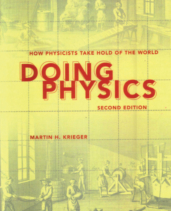By Martin H Krieger
Indiana University Press
Paperback: £16.99 $24.00
E-book: £14.99 $21.99
First published over two decades ago, Doing Physics has recently been released as a second edition. The book relates the concepts of physics to everyday experiences through a carefully selected series of analogies. It attempts to provide a non-scientific description of the methods employed by physicists to do their work, what motivates them and how they make sense of the world.

Martin Krieger began his academic career in experimental particle physics but quickly realised that he was not suited to working in large groups on experiments. Following his PhD, he moved into the social sciences and began working on computing models for city planning. He uses this experience to reflect on the way science is done from a social science viewpoint. His aim is to explain how doing physics is part of familiar general culture.
Krieger claims that physicists employ a small number of everyday notions to “get a handle on the world” experimentally and conceptually. He argues further that these models and metaphors describe the way physicists actually view the world and that to see the world in such terms is to be trained as a physicist. The analogies he chooses to support his ideas are drawn from the diverse areas of economics, computing, anthropology, theatre and engineering. Each of the first five chapters of the book is devoted to exploring each of the analogies in detail.
The book begins with a discussion on division of labour according to the economist Adam Smith’s model of a pin factory. The description of physical situations in terms of interdependent particles and fields is analogous to the design of a factory with its division of labour among specialists. The second chapter considers physical degrees of freedom as the parts of a complex model such as a clockwork mechanism or a computer. Chapter three is devoted to the anthropological theory of kinship and marriage, comparing the rules of relationships to the rules of interaction for the families of elementary particles or for chemical species – who can marry whom is like what can interact with what. The conclusion is that anything that is not forbidden will happen. The theatrical world provides an analogy to creation, where a vacuum is represented by a simple stage setting on which something arises out of nothing. Finally, machine-tool design is used to describe the physicist’s toolkit, where the work of doing physics is like grasping the world with handles and probes.
In the second edition, Krieger has provided some minor revisions to the text and has added a brief chapter on the role of mathematics and formal models in physics. This additional discussion is based on work from two other books he has written in the intervening years. It is questionable whether the second edition is warranted. In this highly technical chapter Krieger goes so far as to discern an analogy of analogies in physics and mathematics – a so-called syzygy.
Krieger claims that the book is for high-school students and upwards. However, it seems more appropriate for a specialized audience. Doing Physics is aimed at sociologists and philosophers of science, rather than at the science community itself. Indeed, for some the experience of reading the book could bring to mind a well known quote by Richard Feynman: “Philosophy of science is about as useful to scientists as ornithology is to birds.” For others, however, the book might provide some useful insights into patterns or relationships between physics and the everyday world that they have not previously considered.





